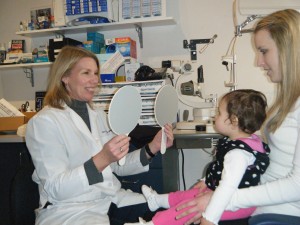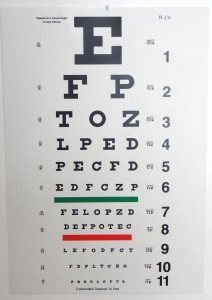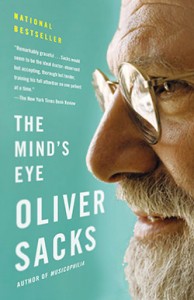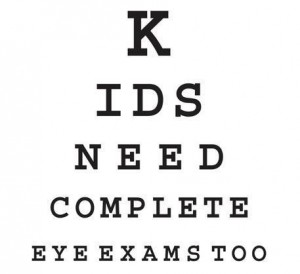An infant’s vision improves significantly during his first 6 months. Basic visual function develops rapidly during the first year.
Newborns focus on objects that are 8-10 inches away and will wince and blink in response to bright light, but only for a brief amount of time. At birth approximate visual acuity is 20/800. Infants will stare intently at high contrast images such as the edges of faces. Newborn eyes may cross or wander for the first 4 months.
By two to three months, babies have an approximate visual acuity of 20/400. At this age, they will track movement as well as smile at objects that are about a foot away. Reaching for objects around 3 months is expected.
At 6 months the vision has improved to at least 20/100. A 6 month old infant will open his mouth to a spoon and will recognize his own face in the mirror. Both eyes should focus equally. Depth perception is developing.
A twelve month old child will have visual acuities of 20/60 and can judge distances fairly well, throw things with precision and pick up small objects with the fingers and thumb.
A comprehensive visual assessment between 9-12 months is recommended, earlier if the infant is at risk for eye or vision disorders. Early intervention is critical to successful vision and treatment.


 Children who do not have the necessary visual-motor and visual-perceptual skills to compete in the class room with their classmates, may act out, be easily distracted or not be able to pay enough attention to perform to their potential. A 15 year long study at the San Bernardino Juvenile Hall revealed that a much higher percentage of juvenile delinquents have vision problems than in the average population. According to the study by optometrists Stan Kaseno and Kristy Remick, poor visual skills can contribute to poor self-esteem, which can lead to poor attitudes and behavior in school. After a program that addressed the inmates problems, including vision and victim’s awareness classes, the repeat offender rate decreased from 90% to 15%.
Children who do not have the necessary visual-motor and visual-perceptual skills to compete in the class room with their classmates, may act out, be easily distracted or not be able to pay enough attention to perform to their potential. A 15 year long study at the San Bernardino Juvenile Hall revealed that a much higher percentage of juvenile delinquents have vision problems than in the average population. According to the study by optometrists Stan Kaseno and Kristy Remick, poor visual skills can contribute to poor self-esteem, which can lead to poor attitudes and behavior in school. After a program that addressed the inmates problems, including vision and victim’s awareness classes, the repeat offender rate decreased from 90% to 15%.



